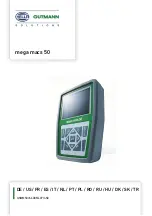
Publication 2364F-5.05 - March 1999
Troubleshooting Faults and Warnings
3-7
17
P177 bit 1
Board Intlk
The voltage feedback connector (J1) or the
current feedback connector (J7) is not
plugged into the isolation board.
Verify that the J1 and J7 connections on the isolation board are
secure and that the wiring is in good condition. Check the AC line
sensor fuses (F17 - 19). In an N-code RGU, check the LEM power
supply located on the upper front of the power structure roll out unit.
18
P177 bit 2
HW Bus OverV
The hardware has detected a DC bus voltage
over 810V DC (380/460V AC) or 1000V DC
(575V AC).
Verify that the setup parameters are programmed appropriately (see
the setup chapter of 2364F-5.01). Also, check the burden resistors
on the isolation board. Check the operation of other drives in the
system.
19
P177 bit 3
HW Line I
The hardware has detected an AC line
overcurrent.
Verify that the setup parameters are programmed appropriately (see
the setup chapter of 2364F-5.01). Check for any shorts to ground.
Also, check the burden resistors on the isolation board. Clear the
fault and try resetting/restarting the RGU.
20
P177 bit 4
Zero Seq Err
The 3-phase input to the unit is out of
balance. The current vector sum is not near
zero.
Clear the fault and try resetting/restarting the RGU. Verify that all
connections to the main control board are in place, and check the
main control board for any obvious damage or any debris which may
be shorting circuitry. If necessary, try reinstalling the firmware (or
upgrade to the latest available firmware). If the problem cannot be
resolved, contact Rockwell Automation for hardware updates. If
necessary, replace the main control board and/or send the board to
Rockwell Automation for testing.
21
P177 bit 5
Phase Lock L
One or more phases from the AC line have
lost power or have browned out.
The RGU can continue to operate until power is lost from two
phases, or until power becomes too low for the RGU to compensate
to load. If the phase(s) do not return, verify that the circuit breaker is
closed, check the power source, check all AC connections, check
the incoming AC line fuses (F1, F2, F3), and check for shorts to
ground (PE). If there is no actual phase loss, check the AC line
sensor fuses and the J1 connection to the isolation board.
22
P177 bit 6
Phase Loss
A phase from the AC line has lost power.
The RGU can continue to operate on single-phase power, but may
trip if the load becomes too great, or may trip if the RGU is forced to
regenerate. If the phase does not return, check the power source,
check the incoming AC line fuses (F1, F2, F3), and check for shorts
from the lost phase to ground (PE). If there is no actual phase loss,
check the AC line sensor fuses and the J1 connection to the isolation
board.
23
P177 bit 7
Not Used
24
P177 bit 8
Not Used
25
P177 bit 9
Not Used
26
P177 bit 10
SW Line I
The software has detected an AC line
overcurrent.
Verify that the setup parameters are programmed appropriately (see
the setup chapter of 2364F-5.01). Check for any shorts to ground.
Also, check the burden resistors on the isolation board.
27
P177 bit 11
I Offset Err
An excessive line current has been detected
during initial power up.
Check the parameters for any unusual current settings. Check for
any shorts to ground. Verify that the correct burden resistors are
installed on the isolation board.
Note:
‘W’ indicates that the condition is normally reported as a warning, rather than a fault.
Number Fault
Indicates
Action
















































